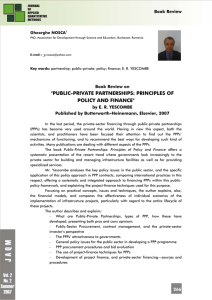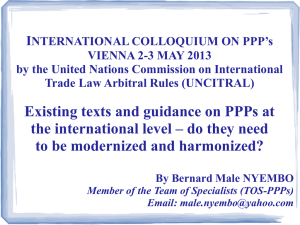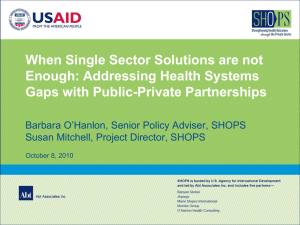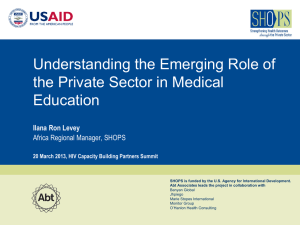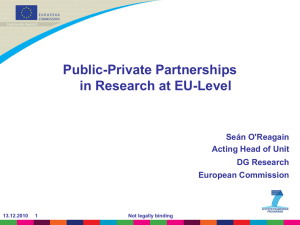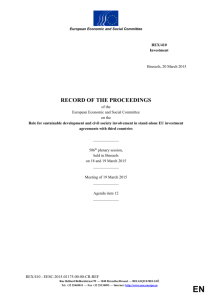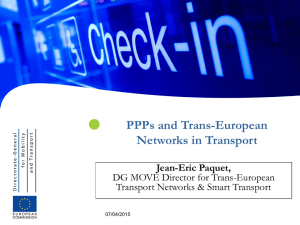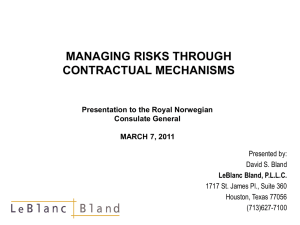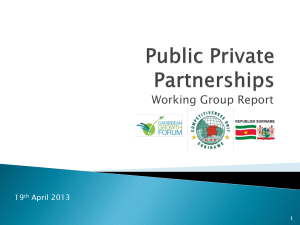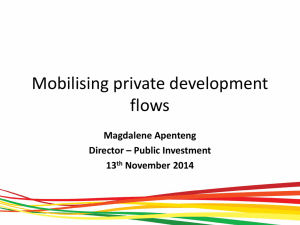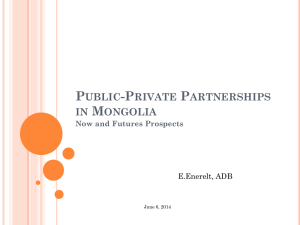Research Paper #2
advertisement
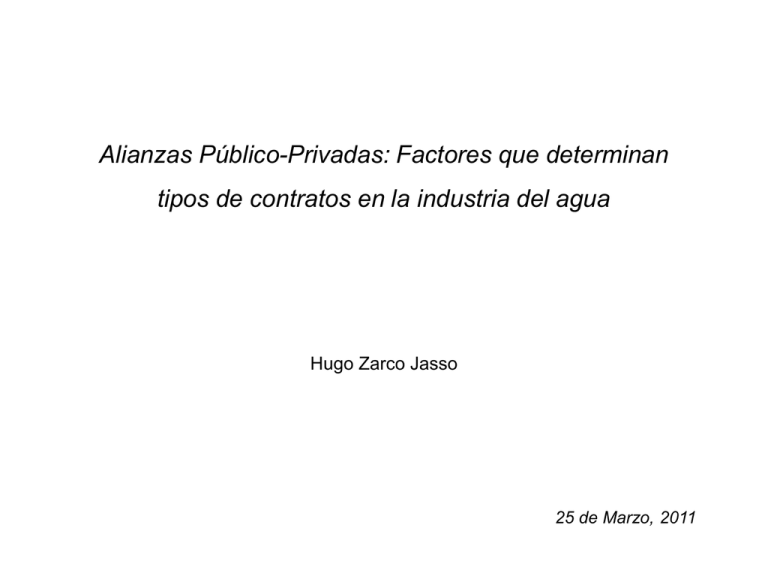
Alianzas Público-Privadas: Factores que determinan tipos de contratos en la industria del agua Hugo Zarco Jasso 25 de Marzo, 2011 MOTIVATION AND RESEARCH QUESTION Motivation: To examine the factors determining the adoption of various forms of “hybrid” public-private governance structures Theoretical Perspectives: •Public Management •International Management •Institutional Economics Research Question: “What determines the degree of private participation in public-private contractual arrangements?” CONCEPTUAL FRAMEWORK AND EMPIRICAL ANALYSIS CONCEPTUAL FRAMEWORK Research Paper #1 • Framework for analysing the relationship between public and private organizations entering into PPP within the context of cross-sector collaboration. • Build on public and private organization to develop a model for mapping PPPs into a continuum of hybrid organizations. EMPIRICAL STUDIES Research Paper #2 • Analysis of contract entry mode as the outcome of negotiation between multinational companies and host countries. • Results of this process are strongly affected by the unequal distribution of resources between the parties and by the limited competition in the sector. • Existing contract modes are not flexible enough to accommodate uncertainties and shift bargaining power between partners. Research Paper #3 • Comparative analysis of performance for different contractual arrangements in the Spanish water Industry • Results offer evidence that that consumers pay more when municipalities choose PPPs, controlling for other aspects of supply and demand in water distribution that could affect prices. •Local government decisions are not necessarily based on efficiency grounds. CONCEPTUAL FRAMEWORK AND EMPIRICAL ANALYSIS CONCEPTUAL FRAMEWORK Research Paper #1 • Framework for analysing the relationship between public and private organizations entering into PPP within the context of cross-sector collaboration. • Build on public and private organization to develop a model for mapping PPPs into a continuum of hybrid organizations. EMPIRICAL STUDIES Research Paper #2 • Analysis of contract entry mode as the outcome of negotiation between multinational companies and host countries. • Results of this process are strongly affected by the unequal distribution of resources between the parties and by the limited competition in the sector. • Existing contract modes are not flexible enough to accommodate uncertainties and shift bargaining power between partners. Research Paper #3 • Comparative analysis of performance for different contractual arrangements in the Spanish water Industry • Results offer evidence that that consumers pay more when municipalities choose PPPs, controlling for other aspects of supply and demand in water distribution that could affect prices. •Local government decisions are not necessarily based on efficiency grounds. Research Paper 1 NEED OF A THEORETICAL FRAMEWORK • Definition: PPPs can be defined as cooperative agreements where public sector agencies enter into long-term contractual relationships with private sector entities for the construction or management of public sector infrastructure facilities by the private sector entity. • Public-private partnerships (PPPs) have been developed in the context of ‘New Public Management’ (NPM) reform assumptions are important. • In practice, experiences with PPPs have been mixed in developing countries (Estache, 2004; Guasch et al., 2003) as well as in developed countries (Engel et al., 2008). Research Paper 1 INTENDED THEORETICAL CONTRIBUTION • Despite there exists a burgeoning literature on the topic of privatization there has been little systematic work on the determinants of the mix of public-private participation (Mahoney et al., 2009). • A key issue in the proposed framework is to change how the term “public” is to be understood when referring to public services because it is confusing to equate “public” with public ownership. • Apart from asset ownership, private sector involvement in the provision of public services has two distinct elements: operational and financial. Research Paper 1 EXTENDED FRAMEWORK: HYBRID CONTRACTUAL ARRANGEMENTS • By considering that no organization is wholly public or private the proposed framework builds on three dimensions: – Control of operations: the justification for the involvement of the private sector is essentially managerial. – Funding of underlying project: considered as a commodity that can be equally raised by both sectors. – Ownership of assets: overall, private ownership offers more incentives for cost reduction, but these incentives can induce quality erosion. • Main insight: Ensuring quality under private participation requires increased oversight (and ownership). As the difference between public and private ownership disappears, the potential for cost savings from private ownership may disappear as well. Research Paper 1 TYPES OF PUBLIC-PRIVATE PARTNERSHIP CONTRACTS Dimension Control Funding Ownership Operations and Maintenance Capital Investment Asset Ownership Public Public Public Public/Private Public Public Management Contract Private Public Public Leasing Contract Private Public Public Concession of existing network Private Private Public BOT Build, Operate and Transfer Private Private Private then Public Divestiture Privatization Private Private Private Types Public agency management non-PPP Service Contract outsourcing CONCEPTUAL FRAMEWORK AND EMPIRICAL ANALYSIS CONCEPTUAL FRAMEWORK Research paper #1 • Framework for analysing the relationship between public and private organizations entering into PPP within the context of cross-sector collaboration. • Build on public and private organization to develop a model for mapping PPPs into a continuum of hybrid organizations. EMPIRICAL STUDIES Research paper #2 • Analysis of contract entry mode as the outcome of negotiation between multinational companies and host countries. • Results of this process are strongly affected by the unequal distribution of resources between the parties and by the limited competition in the sector. • Existing contract modes are not flexible enough to accommodate uncertainties and shift bargaining power between partners. Research paper #3 • Comparative analysis of performance for different contractual arrangements in the Spanish water Industry • Results offer evidence that that consumers pay more when municipalities choose PPPs, controlling for other aspects of supply and demand in water distribution that could affect prices. •Local government decisions are not necessarily based on efficiency grounds. Research Paper 2 MOTIVATION • Entry mode: – Critical element of international expansion – Strategic decision costly to reverse • Research question: “What are the determinants of contract type as the outcome of bargaining between host countries and MNCs prior to project initiation?” • Previous work in IB literature have analyzed firm-specific advantages as reflected in the amount of ownership in an equity vs. non-equity setting. Research Paper 2 BARGAINING MODEL OF MNC-HOST GOVERNMENT RELATIONS Research Paper 2 HYPOTHESES RELATED TO THE EFFECT OF SOURCES OF BARGAINING POWER ON CONTRACT DIMENSIONS Supported P. Supported Supported Not Supported P. Supported Supported Supported Research Paper 2 SAMPLE SIZE OF WATER PROJECTS WITH MNCs Research Paper 2 DESCRIPTION OF DATA CONCEPTUAL FRAMEWORK AND EMPIRICAL ANALYSIS CONCEPTUAL FRAMEWORK Research paper #1 • Framework for analysing the relationship between public and private organizations entering into PPP within the context of cross-sector collaboration. • Build on public and private organization to develop a model for mapping PPPs into a continuum of hybrid organizations. EMPIRICAL STUDIES Research paper #2 Research paper #3 • Analysis of contract entry mode as the outcome of negotiation between multinational companies and host countries. • Comparative analysis of performance for different contractual arrangements in the Spanish water Industry • Results of this process are strongly affected by the unequal distribution of resources between the parties and by the limited competition in the sector. • Results offer evidence that that consumers pay more when municipalities choose PPPs, controlling for other aspects of supply and demand in water distribution that could affect prices. • Existing contract modes are not flexible enough to accommodate uncertainties and shift bargaining power between partners. •Local government decisions are not necessarily based on efficiency grounds. Research Paper 3 MOTIVATION • This chapter tries to identify the factors that make public-private partnerships (PPPs) a more or less efficient alternative for service provision. • This study tries to extend similar previous work (e.g. Menard and Saussier, 2002) that has put aside institutional factors that are not related to efficiency. • Research question: “What is the relationship between the type of contractual arrangement chosen and the associated performance?” Research Paper 3 WATER DISTRIBUTION IN SPANISH MUNICIPALITIES • We use a database that provides information on 1207 municipalities that decided either to maintain public provision or enter into a PPP (i.e. leasing, concession, mix society). • It represents 43% of the Spanish population for a period of seven years. Urban water mana gement in Spain (2003, as percentage of population served) Percentage Market share of Management regime (population) private bu siness Direct Management (Public ) 50.2% -Agbar Group 25.3% 50.8% Aqualia (FCC Group) 9.7% 19.4% Bouygues Gro up 6.7% 13.4% Other private operators 6.5% 13% Source: River Basin Institutions and Agbar DEFINITION OF VARIABLES AND DESCRIPTIVE STATISTICS 18 Research Paper 3 MODEL SETTING • Utility function for partnering: • Price equation for municipality i: =-0.48, =0.25, = 0.178 euros/m3 Research Paper 3 ESTIMATION RESULTS • Consumers pay less when municipalities choose leasing contracts (controlling for other aspects of supply and demand in water distribution that could affect prices). • In contrast to previous findings that focus on variables related to the governance per se, it shows that contract decisions –in a politically salient industry like water– are not necessarily based on efficiency criteria. OVERALL CONCLUSIONS • Despite growing experience in using public-private partnerships it has not translated into clear strategies for contracting and measuring their performance. – Performance of public and private sector companies should not be generalized. – Even within the private sector companies, their performances varies significantly from one city to another, and also could vary over time even in the same municipality. • Current debate on private participation has become extremely polarized (focused on who owns the assets in water utilities) it will only result in the kind of debate that is more prone to ideology than substance. OVERALL CONCLUSIONS • Existing contracts modes are not flexible enough to accommodate uncertainties and to shift bargaining power between governments and investors over the life of infrastructure projects Need of new arrangements that help to reverse recent decline in the number of water infrastructure projects and better balance interests
